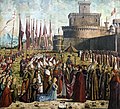Ursula cycle

The nine-part Ursula cycle by Vittore Carpaccio (1490/95) was created for the Scuola Sant'Orsola in Venice. It provides individual stages of the legend of Saint Ursula from Cologne in paintings is, from the marriage proposal of the English prince to its apotheosis .
This schola, one of the typical schools , was supported by members of the noble Loredan family, who commissioned the then unknown painter to create the altar painting (pala) and the eight associated canvas paintings (teleri). Today the cycle can be viewed in a separate room in the Gallerie dell'Accademia in Venice.
The altar painting
The painting of the high altar shows the apotheosis of St. Ursula on a pedestal made of palm leaves surrounded by her virgins.
The eight canvas paintings
The dream of St. Ursula (1495)
For details and excerpts from the nine cycles see Accademia (Venice): COMMONS
The paintings as a mirror of the Venetian society
The framework of the representation is based on a homologation formula: pagan England and Christian Brittany are transferred to Turkish Byzantium and the Venice of the Renaissance.
Geographical reference of the paintings
The Ursula story can be divided into two groups, which were originally attached to the south or north wall. The fourth painting hung on the west side opposite the altar painting. On the north side of the Scuola is the church of Santi Giovanni e Paolo , while the south side faces the Doge's Palace .
The three paintings on the south wall (1st - 3rd) show scenes from the world of diplomacy, while the northern side (5th - 8th) depicts the martyrdom of the saints. The 4th painting above the entrance shows the crossing of the English prince to Brittany and thus symbolizes the mediation between the worldly and the spiritual side.
Architectural reference of the paintings
In the first picture the decorated arch of the altar apse of the original room is taken and shown as a collonnade. In the last picture (8th) Ursula is carried on her bier up a flight of stairs towards the altar - as if Ursula were brought out of the picture into real space to her altar, in which there was a relic of her. Both the first and the last picture of the cycle are attached to the altarpiece as well as to the architecture of the room. Another reference to the room can be found in the first picture, where a piece has been left out for the door.
literature
- Pompeo Molmenti : The Life and Works of Vittore Carpaccio. London 1907. Chapter 4: The History of the Scuola di Sant'Orsola. Chapter V. Carpaccios Paintings. Full text
- Felix Türlemann: The Ursula Cycle by Vittore Carpaccio. Constance 2002. ( online )







